Pest control is an essential aspect of maintaining a safe, comfortable, and habitable living environment, whether in a single-family home or a multi-unit apartment complex. But who’s responsible for dealing with the issue when pests invade a rental property? Is it the landlord or the tenant?
Understanding the answer to this question is crucial for both tenants and landlords alike, as it helps prevent disputes and ensures the rental property remains pest-free and in compliance with legal standards. In this article, we’ll explore the responsibilities of landlords and tenants regarding pest control, examine legal obligations, and provide guidance on how to handle pest infestations effectively.
Understanding Tenant and Landlord Responsibilities
When you sign a lease agreement, both parties – the landlord and the tenant – are bound by specific responsibilities to maintain the rental property. These obligations are often detailed in the lease and are generally governed by local laws.
Landlord Responsibilities
In most jurisdictions, landlords are required by law to ensure their properties are habitable. This means the property must be safe, sanitary, and fit for living, which includes being free from infestations of pests like rodents, cockroaches, termites, and bedbugs. Under the Implied Warranty of Habitability, landlords must address major issues that affect a tenant’s health and safety, including pest problems.
Additionally, landlords are responsible for maintaining the structural integrity of the property. If an infestation is due to a failure in the building’s structure, such as leaks, cracks, or gaps in the walls, then it’s the landlord’s responsibility to fix these issues and control the pest population.
Tenant Responsibilities
While landlords must handle major pest control issues, tenants are also expected to take reasonable steps to maintain a pest-free living environment. Tenants are responsible for ensuring cleanliness, proper waste disposal, and sealing food items to avoid attracting pests. If a tenant’s actions contribute to an infestation, the responsibility for pest control may shift to them.
For example, a tenant who leaves food crumbs or doesn’t properly dispose of garbage may attract pests, which then require action on their part. Likewise, if a tenant brings in infested furniture, they may be liable for pest control.
What Does the Law Say About Pest Control?
The responsibility for pest control often depends on local and state laws. However, in most places, there are clear guidelines that hold landlords accountable for maintaining a pest-free rental property.
Legal Obligations of Landlords
Under the Implied Warranty of Habitability, landlords are required to provide a livable environment for tenants. This includes maintaining the property in a condition free from health and safety hazards, which typically covers pest infestations. If a tenant experiences issues like termites, rodents, or bedbugs, the landlord is usually required by law to address these concerns promptly.
In certain states, tenants can even withhold rent or demand repairs if a landlord fails to address pest infestations. Some localities may have more specific laws regarding pests, such as mandatory inspections for bedbugs or other pests before a tenant moves in. In these cases, the landlord must ensure that the property is pest-free before renting it out.
Tenant Rights
Tenants have the right to live in a pest-free environment, and if pests are present, they can request that the landlord handle the issue. If a landlord refuses to take action, tenants may be able to take legal action. For example, in some states, tenants can contact local health departments or pest control services to address the issue.
Moreover, many areas have health and building codes that specifically address pest control. Landlords are obligated to comply with these codes, ensuring that the property remains habitable and safe for tenants.
When Landlords Are Responsible for Pest Control
There are specific circumstances where landlords are responsible for pest control, particularly when the infestation is due to structural issues or occurs before the tenant moves in.
Infestations Present Before Tenant Move-In
If a property has pests before a tenant moves in, it is the landlord’s responsibility to address the infestation. This is especially true for persistent issues like termites or rodents, which could damage the property or pose health risks to the tenant. A landlord must ensure that the property is thoroughly inspected and free from pests before the lease begins.
Structural Problems Contributing to Pest Infestation
If the infestation is caused by structural issues such as cracks, holes in walls, damaged windows, or poor insulation, it’s the landlord’s responsibility to make the necessary repairs. Pests often enter buildings through such openings, and without fixing these issues, infestations are likely to recur. For example, a tenant cannot be expected to fix a leaky roof that allows rodents to enter the property, so the landlord must take action to prevent further infestations.
Common Areas in Multi-Unit Properties
In multi-unit apartment buildings, pest problems in shared spaces such as hallways, laundry rooms, or lobbies fall under the landlord’s responsibility. If pests in common areas spread to individual apartments, the landlord is required to provide pest control treatments for the entire building. This includes treating structural issues or any areas where pests are likely to enter.
When Tenants Are Responsible for Pest Control
While landlords bear the brunt of pest control responsibility, tenants are not off the hook entirely. There are situations where tenants can be held responsible for pest control, especially if they’re directly or indirectly causing the problem.
Tenant Actions Leading to Pest Problems
If a tenant’s behavior contributes to the pest problem, they may be required to take responsibility for pest control. This is often the case if a tenant’s failure to maintain cleanliness attracts pests like cockroaches, ants, or rodents. For example:
-
Food left uncovered or improperly stored attracts pests.
-
Garbage not disposed of regularly may create breeding grounds for pests.
-
Cluttered environments may provide hiding places for pests.
-
Pets that are not properly treated for fleas may lead to an infestation in the unit.
In these instances, the landlord might require the tenant to take corrective action or hire a pest control company at their own expense.
Bringing in Infested Furniture or Items
If a tenant moves into a rental property and unknowingly brings in furniture or items that are infested with pests, they might be held responsible for pest control. This often occurs with pests like bedbugs, which are commonly spread through furniture and clothing. While the landlord must address the issue if it spreads, tenants may be liable if the infestation started with their belongings.
Landlord-Tenant Communication: Best Practices
Clear communication between landlords and tenants is key to resolving pest control issues effectively. Here are some best practices for both parties:
For Tenants:
-
-
Report pest issues early: The sooner a tenant reports a pest problem, the easier it will be to manage and resolve.
-
Follow the proper reporting procedure: Tenants should use the methods outlined in the lease or building rules to notify the landlord.
-
Document the issue: Taking photos or videos of pests can help provide evidence if the landlord fails to act.
-
For Landlords:
-
Address pest problems promptly: As soon as a pest issue is reported, the landlord should arrange for inspection and treatment.
-
Ensure regular maintenance: Routine inspections can help prevent infestations from taking root.
-
Keep records: Document all pest control actions taken to ensure compliance with local laws.
How to Prevent Pests in Rental Properties
Both landlords and tenants can take steps to prevent pests from becoming a problem. Here are some key preventative measures:
For Landlords:
-
Regular property inspections to identify any signs of pest activity.
-
Seal cracks and holes in walls, doors, windows, and around pipes.
-
Maintain landscaping to keep bushes and trees away from the building, as these can harbor pests.
For Tenants:
-
Clean regularly and dispose of trash promptly.
-
Store food in sealed containers to avoid attracting pests.
-
Seal entry points by using weather stripping on doors and windows.
What Happens If a Landlord Fails to Address Pest Problems?
If a landlord does not fulfill their responsibility to address pest infestations, tenants have several options:
-
Legal Action: Tenants can file complaints with local housing authorities or health departments, which may force the landlord to take action.
-
Withholding Rent: In some jurisdictions, tenants may have the right to withhold rent if the landlord fails to maintain a habitable property.
-
Lease Termination: If the pest issue makes the property uninhabitable, tenants may be able to break the lease without penalty.
1. Is pest control considered a landlord’s responsibility?
Yes, pest control is generally considered the responsibility of the landlord, especially if the infestation is due to structural issues or if the pests were present before the tenant moved in. Landlords must provide a habitable living environment, free from health and safety hazards, which includes dealing with pest problems like rodents, termites, or bedbugs. However, if the infestation results from tenant neglect, such as poor hygiene or bringing in infested furniture, the tenant may be responsible.
2. What should I do if my landlord refuses to take care of a pest problem?
If your landlord refuses to address a pest problem, start by documenting the issue in writing. Notify them formally, either by email or letter, and request pest control treatment. If the landlord still doesn’t act, you may have the right to withhold rent, contact local health departments, or take legal action. In some cases, you can also break your lease if the property becomes uninhabitable.
3. Can a landlord charge tenants for pest control?
Generally, landlords are responsible for pest control, but tenants may be charged if the infestation was caused by their actions. For instance, if pests result from the tenant’s poor hygiene or if they bring in furniture that’s already infested, the landlord may charge for pest control services. Always check your lease agreement for specific clauses related to pest control costs.
4. How do I know if pests were already in my apartment when I moved in?
To determine if pests were already present, inspect the apartment thoroughly before moving in. Look for signs of infestations such as droppings, gnaw marks, or holes in walls. You can also request the landlord to have the property professionally inspected before you move in. Document any signs of pests in writing and take photos if possible.
5. Are landlords responsible for bed bug infestations?
Yes, landlords are typically responsible for bed bug infestations, especially if the problem existed before the tenant moved in. However, tenants may be responsible for bed bug treatment if they bring infested furniture or personal items into the unit. In many areas, landlords are required to handle bed bug issues promptly to ensure the property remains habitable.
6. What pests are landlords typically responsible for dealing with?
Landlords are generally responsible for dealing with pests that pose a health risk or structural damage. Common pests landlords are responsible for include:
-
Rodents (rats, mice)
-
Cockroaches
-
Termites
-
Bedbugs
-
Ants and other insects
Pests caused by tenant neglect (like fleas due to lack of pet care) may fall under tenant responsibility.
7. Can I terminate my lease if my landlord doesn’t handle a pest infestation?
In some cases, yes. If the pest infestation makes the rental unit uninhabitable and the landlord fails to address it, you may be able to terminate the lease early without penalty. It’s important to follow the proper legal procedure in your state, which may include notifying the landlord in writing and giving them an opportunity to fix the problem. Always consult local housing laws for guidance.
8. How can I prove that pests were in the apartment before I moved in?
Proving that pests were in the apartment before you moved in can be difficult, but it’s possible. Keep a detailed record of any pests you encounter, including photographs, videos, and written descriptions. If possible, get an inspection from a pest control professional who can confirm the presence of pests. Additionally, reviewing the property’s condition before moving in, such as photos or a walk-through inspection, can help establish a timeline.
Conclusion
When it comes to pest control in rental properties, both landlords and tenants have important responsibilities. Landlords are primarily responsible for ensuring that the property is free of pests and in good condition, while tenants must maintain cleanliness and report pest issues promptly. Clear communication, routine maintenance, and taking preventive measures can help avoid pest problems, ensuring a safe and healthy living environment for everyone involved.







